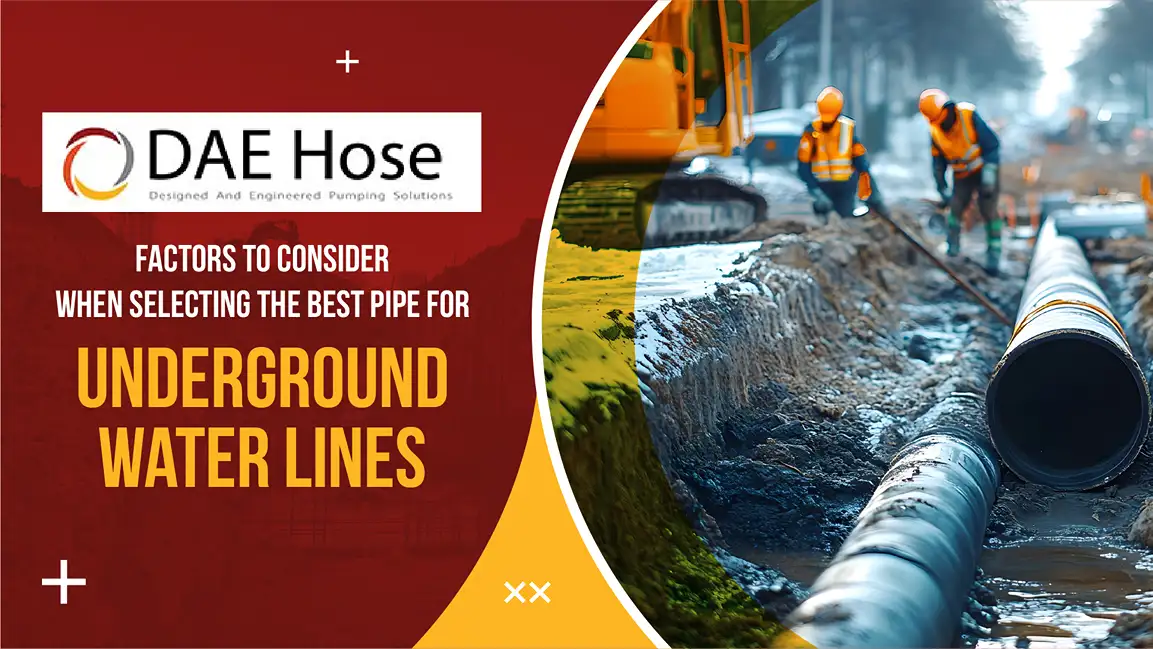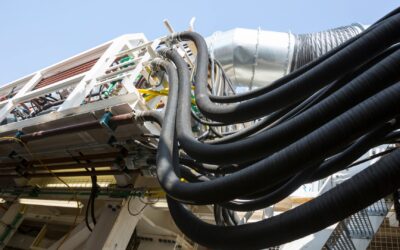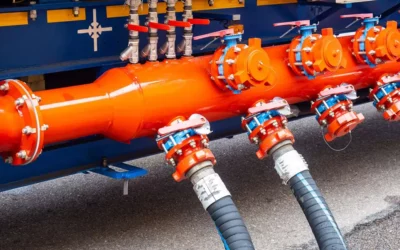The main goal is to select a pipe that offers durability and low maintenance while keeping installation costs reasonable. For industrial water pipe applications, durability against external elements is particularly crucial. By understanding these key factors, you’ll be able to make an informed decision and select the ideal water line pipe for your system.
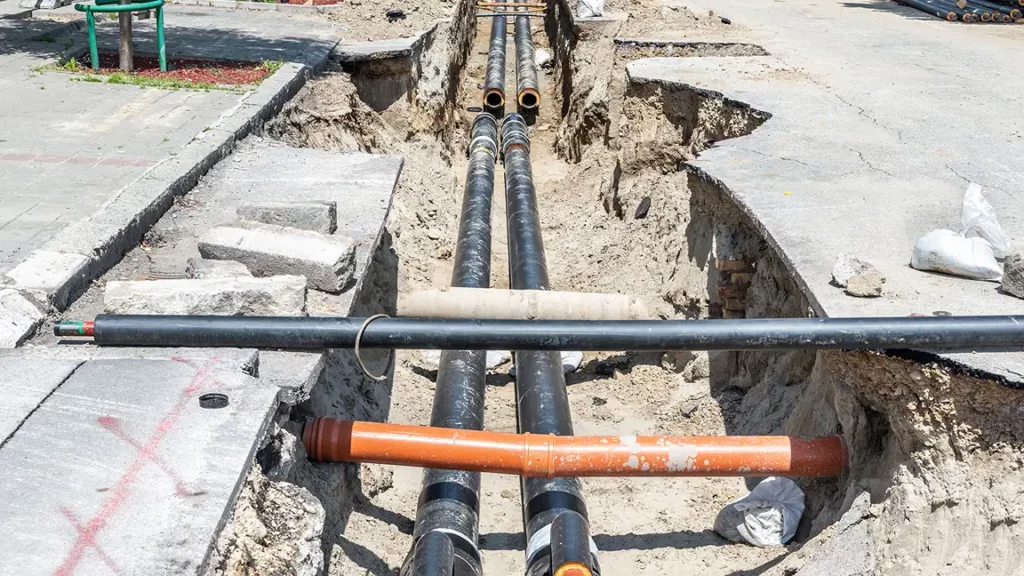
1. Material Selection for Underground Water Pipes
Choosing the right material for underground water pipes is crucial for ensuring durability, cost-effectiveness, ease of installation, and suitability for specific applications. Various materials, including PVC, HDPE, Copper, CPVC, and PEX, are commonly used for water line pipes, and each offers its own set of benefits and drawbacks. Understanding these differences can help in selecting the best pipe for underground water lines based on your specific needs.
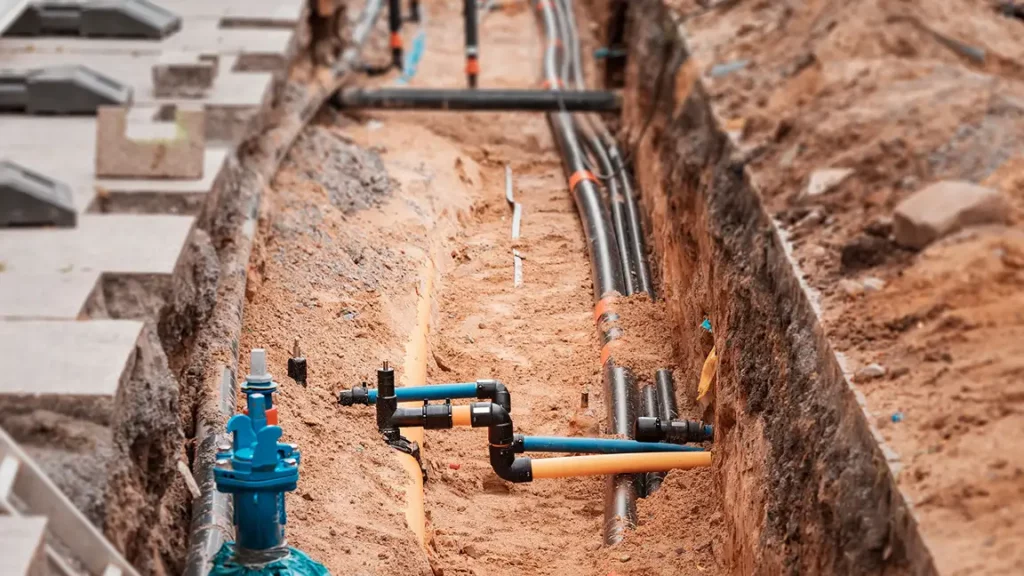
Common Materials Used
PVC (Polyvinyl Chloride) is a popular and affordable option for underground water lines. It is lightweight, corrosion-resistant, and easy to install. PVC pipes also have good pressure-bearing capabilities, making them ideal for residential water lines. Resistant to soil chemicals, PVC is commonly used in drinking water and wastewater systems. Due to its durability and cost-effectiveness, many consider PVC one of the best choices when selecting a water line pipe for underground installations.
HDPE (High-Density Polyethylene) is known for its flexibility and durability, making it ideal for underground water lines, especially in areas with expansive or shifting soils. The flexibility of HDPE helps prevent cracking due to ground movement, and it is resistant to corrosion, abrasion, and a wide range of chemicals. HDPE is also well-suited for colder climates, where it can withstand freezing temperatures without cracking. It’s a strong contender as the best pipe for underground water line in areas with unstable soils. Additionally, HDPE is often used as an industrial water pipe due to its robustness and long-lasting performance, making it a reliable choice for both residential and industrial applications.
Copper: Copper pipes are highly durable and resistant to corrosion, making them a reliable choice for underground water lines. Copper’s resistance to UV rays also makes it suitable for systems exposed to sunlight. However, copper is more expensive compared to other materials and may not be the best option in areas with highly acidic soil, which can cause corrosion over time. Copper pipes are ideal for long-term residential or industrial water pipe applications where durability is a priority, and can be considered one of the best pipes for underground water lines when durability and performance are essential.
CPVC (Chlorinated Polyvinyl Chloride): CPVC is a variant of PVC designed to handle higher temperatures. Although it is most commonly used for hot water systems, it is also suitable for cold water lines. CPVC is corrosion-resistant and offers a long service life. However, it is more brittle than other materials, making it prone to cracking under harsh conditions. It’s generally not recommended for areas with significant soil movement, but it can still be considered a viable option for the best pipe for underground water lines in certain applications where temperature resistance is a key factor.
PEX (Cross-linked Polyethylene): PEX pipes are flexible, easy to install, and resistant to freezing and corrosion. They are ideal for residential water lines, especially in areas with hard water. However, with a lower pressure rating, PEX is less suitable for industrial water pipes.
Durability Considerations
It is key to choose a water line pipe that withstands environmental factors like soil pH and temperature fluctuations. PVC and HDPE are highly resistant to corrosion and offer long-term durability, while copper and CPVC may need more frequent replacement in acidic or alkaline soils. The best pipe for an underground water line ensures lasting performance and fewer repairs.
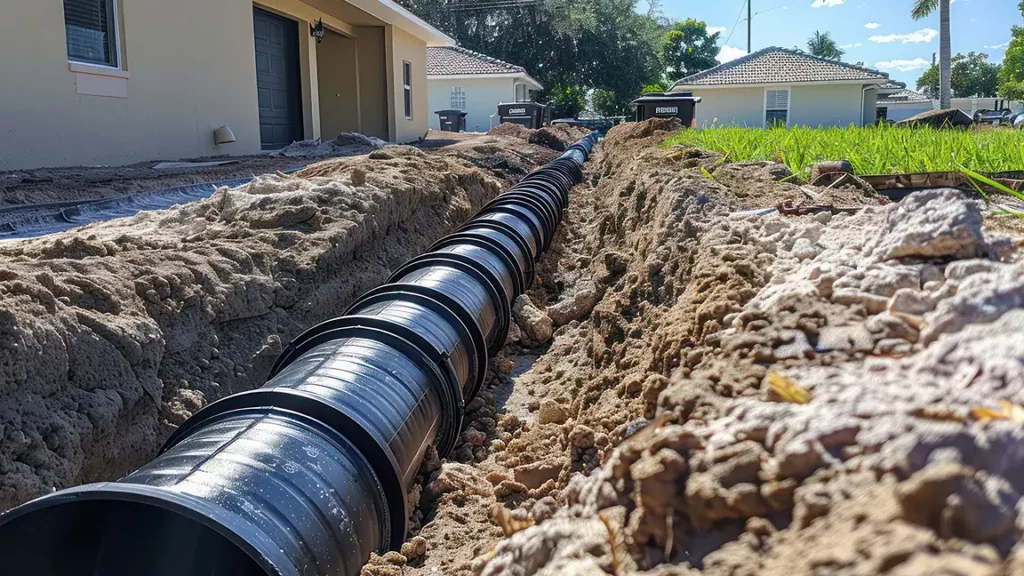
Suitability for Specific Environments
Some materials are better suited for specific environmental conditions. Due to its flexibility, HDPE is ideal for areas with shifting or expansive soils. PVC is better for areas with stable soil and moderate temperatures. While durable, copper may not be the best option for areas with highly acidic soils, as this can accelerate corrosion.
Ultimately, the best pipe for underground water lines will depend on your specific needs, including environmental conditions, budget, and long-term durability. For residential and industrial water pipes, choosing the right material will ensure a reliable, cost-effective solution for years to come.
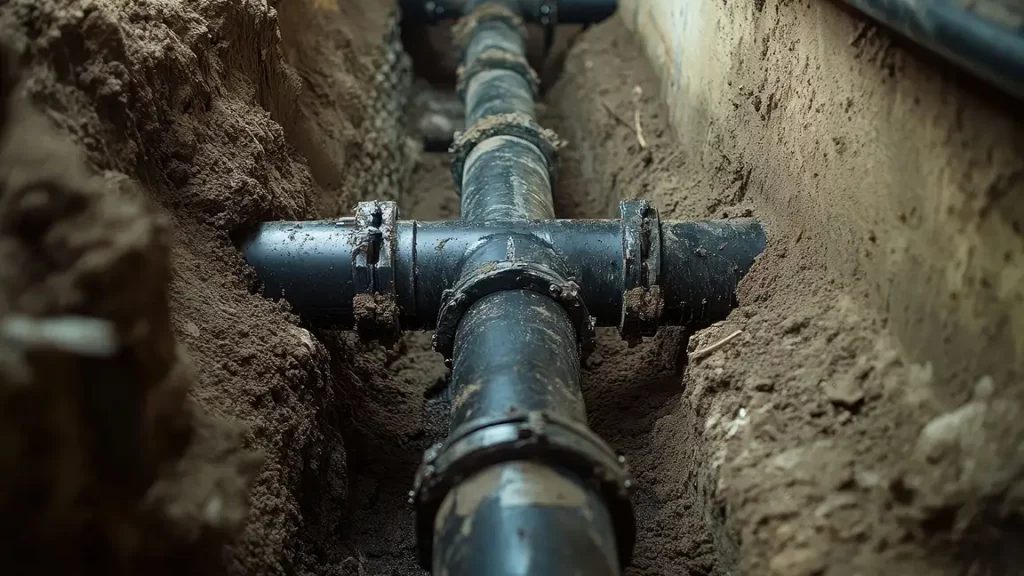
2. Pipe Durability and Longevity
Durability is key when selecting a pipe for underground water lines. A proper installation should last decades with minimal maintenance, so choosing a durable material is crucial to avoid costly repairs. The best pipe for underground water lines needs to withstand environmental conditions and offer long-lasting performance.
Impact of Soil Conditions
Soil type impacts pipe longevity. Acidic or alkaline soil can cause corrosion in metal pipes like copper, while PVC and HDPE are more resistant to chemicals and corrosion. In sandy or moist soils, HDPE’s flexibility and abrasion resistance make it a great choice for water line pipes.
Resistance to External Elements
Environmental factors like UV radiation and extreme temperatures affect pipe durability. HDPE is UV-resistant, making it ideal for sunny areas, while PVC may degrade faster under prolonged exposure. Copper pipes are durable but vulnerable to corrosion in wet or acidic soils. Industrial water pipes require materials that handle these external factors well.
Corrosion Resistance
Corrosion can lead to leaks and pipe failure. Materials like PVC, HDPE, and PEX are non-corrosive, making them ideal for underground water lines. Unlike metals such as copper, which are prone to corrosion in certain soils, these materials significantly extend pipe lifespans.
Longevity Comparison
For the best pipe for underground water line installations, durability is key. PVC and HDPE pipes can last over 50 years with proper installation, offering great resistance to corrosion. Copper pipes also last around 50 years but can corrode in acidic soil. CPVC lasts 20-30 years, and PEX lasts about 40 years but is more vulnerable to UV exposure and freezing. For industrial water pipeline installations, corrosion resistance is crucial. PVC and HDPE are often the most reliable choices for underground water lines, ensuring long-term efficiency and minimal maintenance.
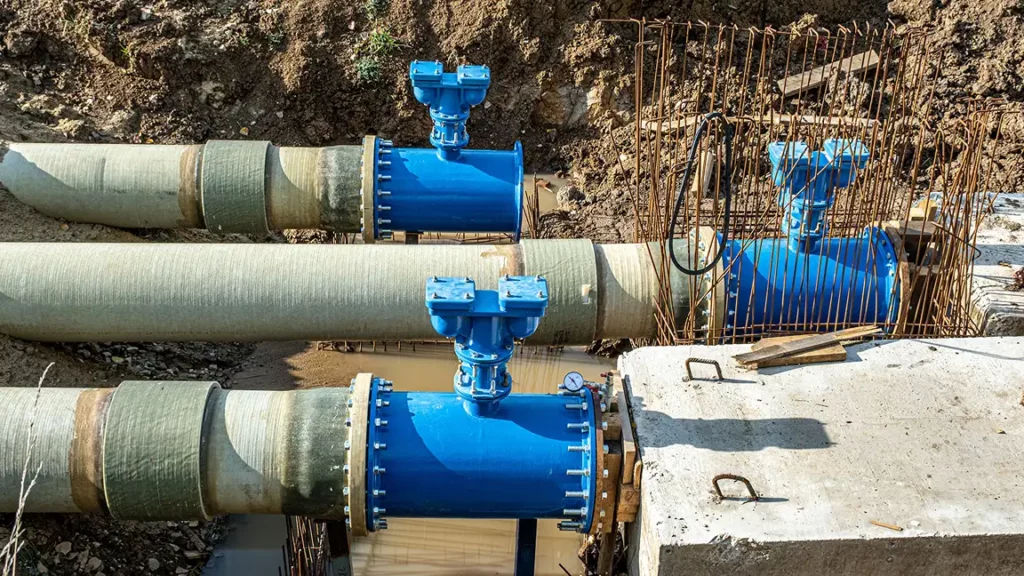
3. Pipe Size and Flow Capacity
Selecting the correct pipe size is crucial for maintaining proper water flow through your system. If the pipe is too small, it can lead to low water pressure, poor flow, and potential blockages. On the other hand, using a pipe that’s too large can result in unnecessary costs and energy waste. For the best pipe for underground water lines, sizing it correctly is key to efficiency and longevity.
Calculating the Correct Pipe Size
Pipe size depends on factors like water flow rate, pressure, and local water usage. Larger diameter pipes are required for high-flow applications, such as industrial or agricultural water lines, to ensure unrestricted water flow. In residential settings, common pipe sizes range from ¾ inches to 1 inch, depending on the water demand. A correctly sized pipe helps maintain steady pressure and prevents performance issues in water line pipes.
Optimal Flow Capacity for Industrial Applications
Industrial water pipes typically require larger sizes to handle high flow rates and pressure demands. HDPE and PVC are popular choices for industrial water lines because of their flexibility, corrosion resistance, and the availability of large diameters. To ensure smooth operation and prevent pipe stress or failure, it’s vital to select the best pipe for underground water lines, tailored to the required water volume. Properly sizing your industrial water pipe helps maintain efficiency while reducing maintenance costs.
When selecting the best pipe for underground water lines, whether for residential or industrial use, ensuring the correct size and flow capacity is essential for optimal performance and long-term reliability.
4. Cost-Effectiveness and Budgeting
The cost of installing underground water lines varies depending on the material, pipe size, and installation complexity. Balancing initial costs with long-term value is key to choosing the best pipe and making a cost-effective decision.
Initial Cost vs. Long-Term Value
PVC and PEX are cost-effective upfront but may require more frequent maintenance or replacement compared to durable materials like copper or HDPE. While copper pipes are more expensive initially, they tend to last longer and can reduce future repair costs, offering long-term value. Choosing the best pipe for underground water lines means considering both upfront costs and the pipe’s expected lifespan.
Upfront Cost Considerations
When considering upfront costs for the best pipe for underground water line installations, material and installation expenses are crucial. PVC is one of the most affordable options for water line pipe installations, while copper is the most expensive. HDPE is more affordable than copper but generally costs more than PVC. Installation costs can also vary—PEX, for example, is easier to install, requiring less labor, which can reduce overall costs, especially for residential applications. Balancing material and installation costs will help determine the most cost-effective solution for your underground water line needs.
Maintenance and Replacement Costs
Pipes that require frequent maintenance or replacement can lead to higher long-term costs. Materials like PVC and HDPE typically require less upkeep, making them more cost-effective for water line pipes. Copper and CPVC, though durable, may require more maintenance, particularly in areas with corrosive soil or water. This can increase long-term costs for both residential and industrial water pipes. When selecting the best pipe for underground water lines, it’s essential to consider the material’s maintenance needs to ensure long-term savings.
Return on Investment
Investing in durable pipes like HDPE or copper may have a higher upfront cost but save money over time with fewer repairs and replacements. These materials offer better value, especially for industrial water pipes and high-demand systems. When selecting the best pipe for an underground water line, it’s important to consider both short-term costs and long-term savings. The best pipe for underground water lines will provide reliable performance, ensuring both durability and cost-effectiveness in the long run.
5. Local Regulations and Code Compliance
Local building codes and regulations are vital when selecting the best pipe for underground water lines. Ensuring your materials meet the necessary codes helps avoid penalties, ensures safety, and maintains system integrity.
Understanding Local Building Codes
Each municipality has specific building codes for water line installations, dictating acceptable materials and practices. Before selecting the best pipe for underground water lines, always verify with local authorities to ensure compliance. Regulations may be stricter for industrial water line pipes to ensure safety and durability.
Permitting and Inspections
Many regions require permits for underground water line installations, which involve plans, inspections, and possible approvals. It’s important to factor in these costs and timelines, whether for residential or industrial water line pipes, to avoid delays and ensure compliance with local regulations.
Compliance with Environmental Standards
Some pipe materials may not meet environmental standards for potable water use, risking harmful chemicals leaching into the water. When selecting the best pipe for underground water line installations, it’s crucial to choose materials that comply with regulations to protect water quality and ensure safe and reliable water delivery.
6. Installation Considerations
Another key factor in selecting the best pipe for underground water lines is ease of installation. Some materials are easier and less expensive to install than others, which can significantly impact the overall project cost.
Ease of Installation
PVC and PEX are easy to work with and don’t require specialized tools, making them ideal for DIY projects or low-cost installations. HDPE requires special fusion welding equipment but is still relatively easy to install with the right tools. Copper and CPVC pipes may require more expertise and additional fittings, increasing labor costs.
Labor and Equipment Costs
The complexity of installing different pipe materials will influence labor costs. For example, installing copper pipes requires more skill and may take longer, leading to higher installation costs. PVC and PEX are faster and more straightforward to install, making them a more cost-effective choice for residential systems. When selecting the best pipe for underground water line installations, considering ease of installation and labor costs is essential for minimizing overall expenses.
Conclusion
Selecting the best pipe for underground water lines depends on factors like material durability, cost, and local building codes. PVC, HDPE, copper, CPVC, and PEX each offer benefits and limitations, with the best choice based on your specific needs, budget, and environment. While upfront costs vary, choosing a pipe with long-term reliability and minimal maintenance is key. Carefully evaluating these factors will ensure safe, efficient, and durable water delivery for years to come.

